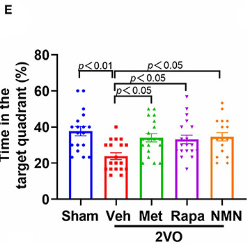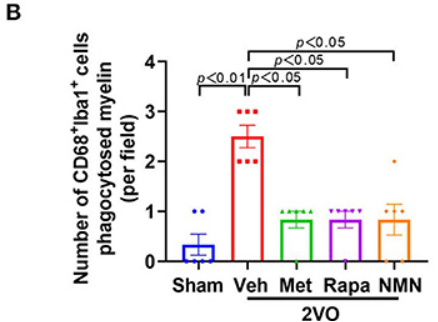NMN, Metformin, and Rapamycin Mitigate Age-Related Cognitive Impairment
The anti-aging compounds NMN, metformin, and rapamycin prevent brain damage and alleviate memory deficiencies in a rat model for age-related cognitive impairment.
Highlights
- Treatment with NMN, metformin, or rapamycin improves learning and memory in rats modeling vascular cognitive impairment (VCI), the second leading cause of dementia after Alzheimer’s disease.
- The compounds reduce brain lesions caused by the lack of blood flow that characterize VCI.
- The degradation of the fatty tissue that makes our neurons fire faster called myelin is prevented by treatment with NMN, metformin, or rapamycin.
While Alzhimer’s gets all the press coverage, not many know about the second leading cause of dementia, VCI. VCI comes from obstructed blood flow to the brain from diseases like heart complications or disorders such as high cholesterol. This leads to cognitive impairment – where people lose their abilities to take care of themselves due to deteriorating brain function. Despite its prevalence, like Alzheimer’s, no therapy currently exists to delay or prevent VCI.
Published in Frontiers in Neurology, Jin and colleagues from the University of North Texas showed that pretreating rats with nicotinamide mononucleotide (NMN), metformin, or rapamycin before experimentally reducing blood flow to the brain to mimic VCI attenuates cognitive impairment. The research team also showed that treatment with any of the three anti-aging molecules reduces brain lesions in VCI rats. Moreover, the occurrence of myelin degradation) declines in rats treated with any of the anti-aging compounds. These findings provide exciting evidence that treatment with NMN, metformin, or rapamycin may provide a means to prevent cognitive decline associated with VCI.
Anti-Aging Compounds Preserve Cognition After Reduced Blood Flow to the Brain
To test the effects of NMN, metformin, and rapamycin on VCI, Jin and colleagues pretreated rats with one of the three anti-aging compounds for 14 days prior to experimentally obstructing blood flow to their brains to model VCI. To determine whether the anti-aging compounds improve the cognitive deficits associated with VCI, the researchers measured learning and memory with the Morris water maze. In the water maze, the rats were trained during four trials to find a submerged platform that would allow them to escape from swimming. Rats that were pretreated with any of the anti-aging compounds spent significantly longer periods in the area that contained the platform, indicating improved memory of the platform’s location. These findings illustrate that NMN, metformin, or rapamycin can restore cognition with obstructed blood flow to the brain, similar to VCI.

To dig into the cell mechanism by which the three compounds exert their cognition-preserving effects, Jin and colleagues looked at the abundance of brain lesions. The researchers found that the treatments more than halved the abundance of lesions. Since these lesions are areas of damage to the brain, reducing their prevalence indicates a preservation of healthy functioning brain tissue, allowing for enhanced cognition.

Jin and colleagues next sought to find how the anti-aging compounds reduced white matter lesions by examining the fatty tissue (myelin) that composes it. Myelin wraps around the axons of neurons allowing for electrical signals to travel at incredibly fast speeds, essentially making the brain fire quicker. They found that rats treated with the three anti-aging molecules underwent significantly less myelin degradation. These results demonstrate that by reducing myelin degradation, white matter is preserved, which improves brain function, and ultimately, cognition.

NMN, Metformin, and Rapamycin Converge on Similar Pathways to Suppress the Elimination of Myelin
The question of what cellular effects NMN, metformin, and rapamycin exert on brain tissue with reduced blood flow has yet to be definitively determined. Previous research indicates that rapamycin inhibits the mammalian target of rapamycin (mTOR) protein from putting microglia cells into degradation mode. In the same regard, metformin stimulates AMP-activated protein kinase (AMPK) proteins that suppress mTOR activity to exert similar effects. NMN stimulates Sirtuin1 proteins that activate AMPK to inhibit the activation of mTOR and then suppress microglia activation. For these reasons, it appears that all three anti-aging compounds converge on similar pathways to inhibit the degradation of healthy myelin under conditions that mimic VCI.
Since none of the three compounds provide more benefit than the others, a cost analysis is suitable to determine which of the three is most cost effective. Metformin costs roughly $13.72 for a month’s supply, whereas rapamycin costs nearly $100 for a month’s supply, while NMN costs around $50 for a month’s supply. While rapamycin and metformin both inhibit mTOR, metformin has the added benefit of regulating glucose metabolism, as it is normally prescribed as a type 2 diabetes medication. Compared to rapamycin and metformin, NMN exerts a broader range of benefits by stimulating sirtuin proteins to combat harmful cell oxidative stress, while also activating the AMPK protein to promote mitochondrial function and suppress mTOR.
Model: Sprague-Dawley rats
Dosage: 100 mg/kg injection of NMN, 100 mg/kg injection of metformin, .25 mg/kg injection of rapamycin

